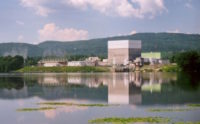Connecticut is developing a road map for other states to follow with the recent launch of the nation's first statewide microgrid pilot program, analysts say. The program, part of Gov. Dannel Malloy's (D) plan to harden infrastructure against future storms, aims to maintain electricity delivery to critical government services and businesses during large-scale power outages, such as the one that struck the state last October as a result of Superstorm Sandy.
The initiative has secured $18 million in funding, primarily through the state's Dept. of Energy and Environmental Protection (DEEP). Approval from the state's bond commission is expected this fall. Malloy has recommended the state add a further $30 million to the program.
"As we move forward with future rounds of funding, we will continue to shape the program to best fit the needs of Connecticut communities," said Daniel Esty, DEEP commissioner, in a statement in July. The program would improve public safety, he added.
The program calls for the development of nine microgrids, or small energy centers, that are powered independently by natural-gas turbines, fuel cells, solar arrays and other energy sources. A total of nine projects using a combination of various energy sources will be set up in the towns of Bridgeport, Fairfield, Groton, Hartford, Middletown, Storrs, Windham and Woodbridge.
The projects range in value and size. For example, Woodbridge's $3-million, 1.6-MW natural-gas-turbine and 400-kW fuel-cell project will power the town hall, a high school and the public-works department as well as the police and fire stations. Further, Windham is planning to spend $639,950 for a combination of natural-gas, solar, battery and diesel systems to supply two schools.
Usually, microgrids contain two or more types of power sources and frequently include renewable-energy sources, says Peter Asmus, principal research analyst at market research firm Navigant Consulting, Chicago. They can be connected to a region's primary grid; however, should the main utility lose power, microgrids can be disconnected and operated independently in "island" mode, he says.
Microgrids are stirring demand worldwide, especially in North America, "but there is no integrated policy for microgrids in the world," Asmus says. "Most states have solar incentives, but [until now] there's been no attempt to have a microgrid policy." Connecticut has taken a big step with this program, and other states will likely watch to see how it develops, he says. New York, still recovering from Sandy, is already considering such a move, he adds.
In the Midwest, nine states recently agreed to collaborate under the existing Mid-West Energy Research Consortium (M-WERC) group—formerly known as the Wisconsin Energy Research Consortium—to boost economic development and job growth associated with microgrid components and systems, Asmus says. M-WERC's membership includes energy, power and control companies.
On the federal level, the Dept. of Defense is developing microgrids for U.S. military bases and remote locations overseas, Asmus adds.




Post a comment to this article
Report Abusive Comment